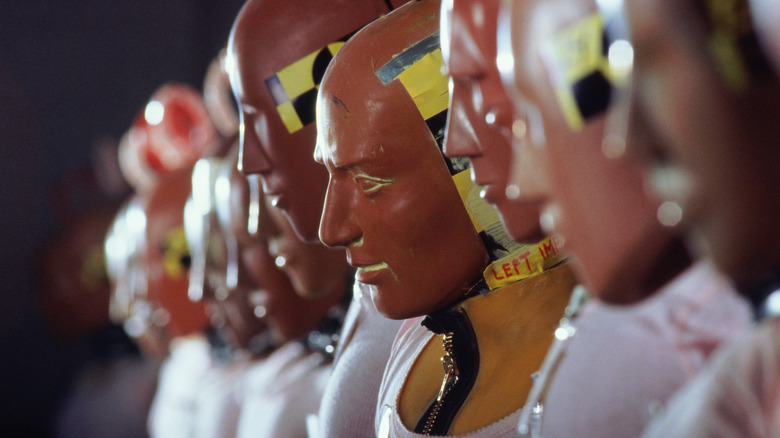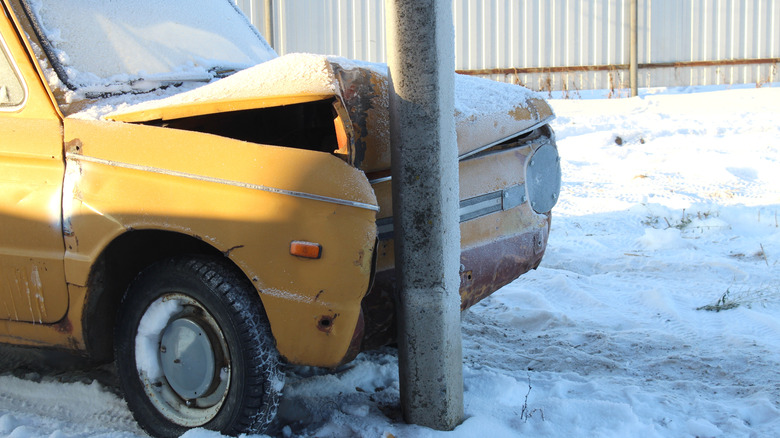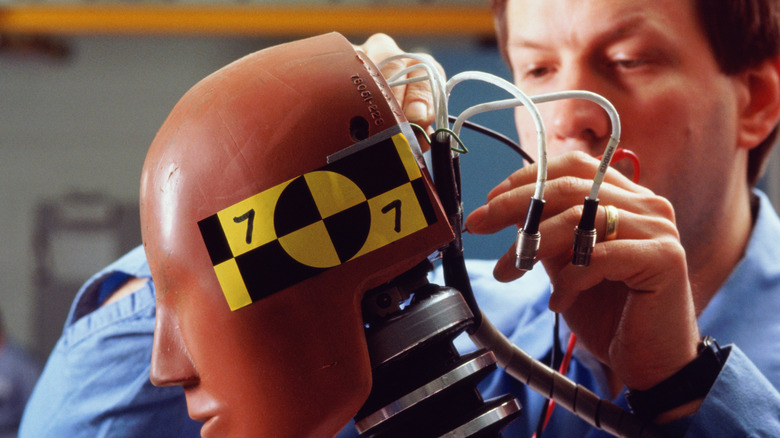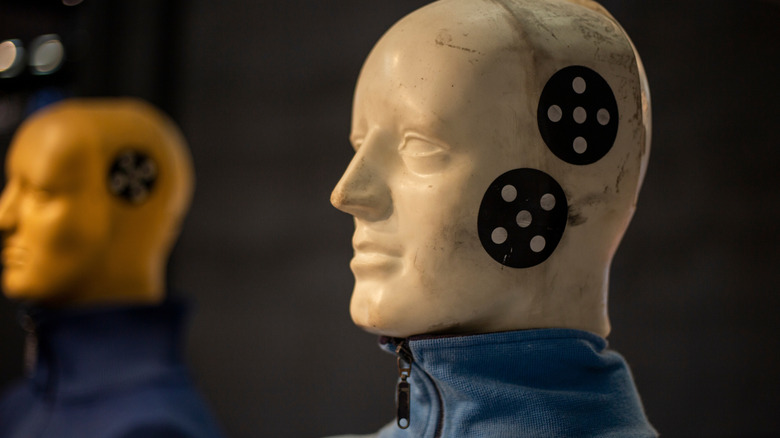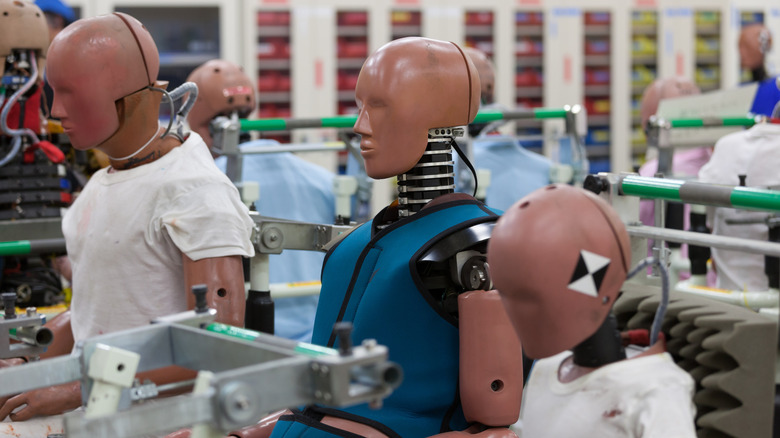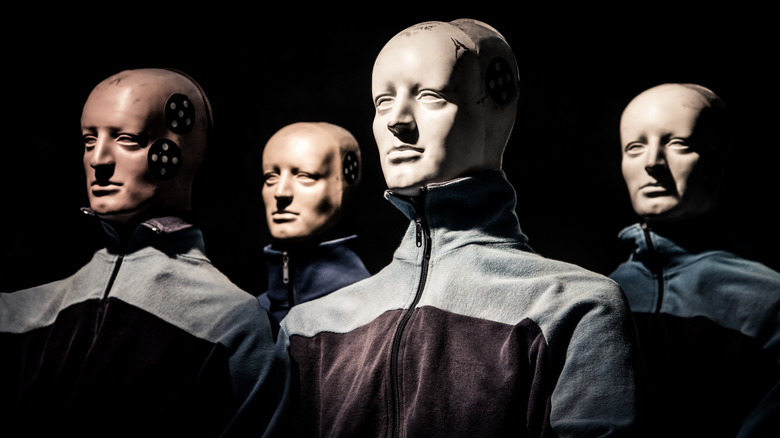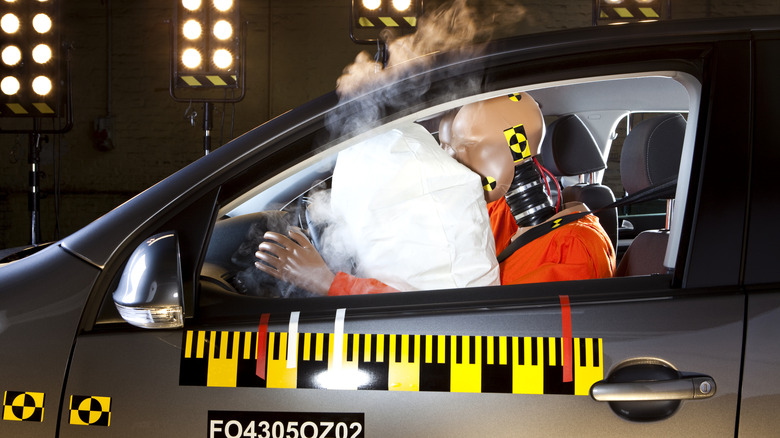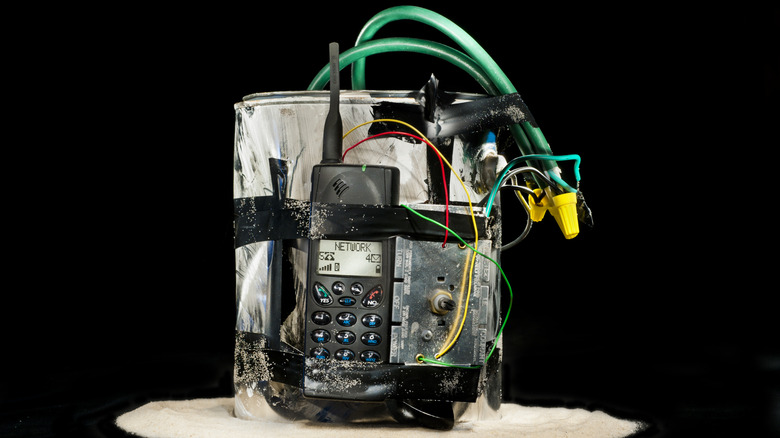The Horrifying History (And Evolution) Of Crash Test Dummies
September 13, 1899. That's the first time on the historical record (in the U.S.) that a person was killed by a car, and it would be far from the last. According to the NSC, motor-vehicle deaths in the U.S. climbed from less than five per 100,000 people in 1913 to a staggering 30.8 per 100,000 people in 1937. Yet, ever since 1937, the number has steadily decreased. It wasn't just improvements in vehicle safety, infrastructure, and education that were responsible. Perhaps one of the biggest contributors to the decline is a device with a pretty horrifying history — the crash test dummy.
Crash test dummies weren't always the mannequins you see launched on an impact sled in slow-mo videos. Throughout their history, their uncanny-valley smiles have belied some pretty messed-up stuff. Some of it will make you grateful for the sacrifices made to keep your car safe. The rest might make you a little weak in the knees. Here's a brief overview of the history of crash test dummies, warts and all.
The following includes discussions of traumatic injuries, cadavers, animal abuse, death, IEDs, and other disturbing topics. Proceed at your own risk.
Before crash test dummies, cars were deathtraps
"They don't build them like they used to," people say about vintage automobiles. They squeak out of collisions with only a scratch on the paint, whilst their modern counterparts are destined for the scrapyard. Modern carmakers design automobiles to crumple easily on purpose to reduce the impact on the driver. Old cars have features that you never see anymore, like crank windows and flip-up lights, but they lack others we take for granted, such as seat belts and airbags.
The IIHS illustrated this perfectly by having a 2009 Chevrolet Malibu and a 1959 Chevrolet Bel Air crash into each other head-on with dummy drivers. The result speaks for itself. On the Malibu, the front end was mangled, but the driver's compartment remained untouched. In the Bel Air, the damage has ripped through half of the vehicle, and it seems unlikely the driver would walk away without significant injuries — if they walk away at all.
Statistics back this up. Fatal injuries in a crash are significantly higher the older a vehicle is, especially if it was made before 1984, according to the NHTSA. Crash test dummies played a pivotal role in creating the modern cars we know today, making them fail "safely" to preserve the lives of the occupants. Of course, it wasn't as simple as putting plastic mannequins in vehicles and making new regulations for pickup trucks or other automobiles.
Some car safety tests use(d) human cadavers
Initially, scientists crash-tested with dead bodies. The first instance of cadavers being used for crash testing goes back to Wayne State University in the 1950s. Scientists dropped a corpse down an elevator shaft to see what would happen when its head hit the metal plate at the bottom (via the BBC). Testing methods, rest assured, improved, but it shouldn't come as a surprise that cadavers can provide a lot of insight into crash testing.
Buckle up, though, because testing with cadavers isn't a thing of the ancient past. Studies up to the mid-2000s have employed them. However, the practice has declined in frequency. Professor Albert King of Wayne State University (the place that did the elevator shaft "crash" test) said that these tests amount to only a few a year these days.
The decline is partially because of the icky nature of using the dead for such destructive testing. However, decades of testing have resulted in insanely safe cars, leaving the possibility of only marginal improvements. If we're being honest, the cadaver part isn't even the worst of it because scientists have also used many, many live subjects.
Some crash tests used live humans
What better way to test the effect of a crash on a human being than with a live one? Many individuals offered themselves as sacrificial car-crashing lambs for the good of humanity. Major John Paul Stapp of the U.S. Air Force and 12 other men were the first to take up that torch in 1951 (via Aero Medical Library). And by testing, we mean being put on a rocket skateboard and going as fast as 620 mph to measure acceleration tolerance, according to Applied Bionics and Biomechanics. As invaluable as this testing was, it's important to note that these tests were somewhat limited in speed and impact for obvious reasons, giving rise to the need for the crash test dummies that would come later.
Another live tester was Lawrence Patrick, who took a staggering amount of scientific "abuse" between 1960 and 1975 (via Salon). Another, Rusty Haight, did over 700 crashes (via NZ Herald). Many more volunteered to help make our cars safer, both in sleds and actual vehicles. Sometimes, these volunteers crashed themselves into trees. So next time you drive a car brand with one of the best safety ratings, give some appreciation to those who went before at great physical risk. It's thanks to them your daily commute doesn't become a bloodbath. Before you do that, though, take your hat off for the animals used in crash testing.
A lot of animals died for crash testing
Animals haven't only been used to test your shampoo. They've been subjected extensively to crash testing. And by extensively, we mean that over 19,000 of them have died to perfect your car's safety systems, according to a New York Times article — and that's only by General Motors Corporation up until 1991. Yikes.
Animal testing kicked off in the 1970s and included everything from dogs to pigs to mice. The article states that the lion's share of test subjects were rodents used to test things like car emissions, but you'd be surprised which animals were subjected to head fractures, chest compression, and other injuries on the impact sleds. Primates and bears are two other examples, as detailed by a 1980 WBI paper.
There are (shocker) a number of issues with using live animals in crash testing, the first of which is obviously the ethicality. Animals are typically anesthetized for any research that causes pain, but that doesn't provide much comfort. Second, even animals similar in anatomy to humans (like primates and pigs) can only provide so much information. You can put pigs in the impact sleds all day long, but it won't be pigs driving the cars. Fortunately, as of 2023, it appears that both General Motors and Ford have halted animal car crash testing.
Samuel W. Alderson invented the crash test dummy
In the interest of a palate cleanser, let's move on to a more positive note. We have Samuel W. Alderson to thank for the invention of the crash dummy.
Born in 1914, Alderson grew up working in a sheet metal shop and, at one point, tried for a PhD in physics under J. Robert Oppenheimer — yes, the guy who introduced the world to clean nuclear energy and the atomic bomb. We'll fast forward through developing missile guidance systems and prosthetic arms to when Alderson built a company tasked with designing, you guessed it, a crash test dummy. At first, this crash test dummy didn't test cars but ejection seats for pilots. Believe it or not, it was thanks to all the prior research with living human beings, cadavers, and animals that allowed Alderson to develop his dummies.
Sierra Sam arrived in 1949 as the first true crash test dummy. Tasked with testing Air Force equipment, later iterations eventually emerged for use in car crash testing. It was one of these dummies that people mistook for aliens in the famous Roswell incident (via Illinois Institute of Technology). Alderson continued developing these iconic devices for decades and is credited with an estimated 330,000 lives saved and millions more injuries prevented, according to Humanetics. He contributed other ingenious inventions like dummies for radiation testing and synthetic wounds for medical training. Alderson passed away in 2005.
The first crash test dummies were for aviation, not automobiles
Remember, Major Stapp was initially strapped (pun intended) into a rocket sled to test planes, not cars. Given how much faster planes go and how devastating the consequences can be when they crash, dummies were a naturally superior option for testing. As mentioned, Samuel Alderson's company was first contracted to make testing dummies for aviation, not automobiles, although that did come later.
Sierra Sam first tested ejection seats, but he had siblings, so to speak. Oscar and Elmer helped study blast tests and the safety of windows upon impact (via FAA). Oscar appeared in 1949, while Elmer showed up in 1951. Both helped develop safety harnesses and were launched on the sled at various Air Force bases. Similar models eventually migrated over to car crash testing. As a somewhat disturbing fun fact, both dummies were used in 1953 for an atomic bomb test. It wasn't until 1966 that Alderson developed his famous VIP-50, one of the early crash test dummies specifically for automobiles.
Crash test dummies have had multiple iterations and versions
The crash test dummy wasn't always the one you're imagining, with black and yellow targets stickered all over it. The evolution from Sierra Sam to the crash test dummies we know today was a methodical, iterative process involving decades and millions of dollars worth of research. The first major crash test dummy was the Hybrid I, developed in 1971, followed by the much improved Hybrid II in 1972. These early versions did a poor job of mimicking human biomechanics — that is, how various systems of the human body work and react to crashes — and by 1977, the Hybrid III had replaced it, eventually becoming the gold standard.
However, this was only a dummy suited for frontal impact testing — head-on collisions, fender benders, etc. — so other dummies were developed for different situations, such as the SID (side impact dummy for a t-bone accident). There was the issue of dummies only representing adult males. Not everyone in a crash is almost 5-foot-8-inches and 180 pounds. Thus, the Hybrid III family was born. It included dummies to represent everyone, including small children and infants. Development for dummies didn't stop there. The most recent, most advanced crash test dummy is the THOR.
Crash test dummies are one reason we started buckling up
Most people automatically do one thing once they get in the car: put on their seat belts. It's the law to do so everywhere except in one U.S. state. These days, there are even seat belts for dogs. Anyone who chooses not to strap in, whether out of laziness or trying to appear tough, does so knowing they'll fly through the windshield headfirst in a crash. Yet anyone who lived through the '80s — or earlier — knows that almost no one wore them back then, despite how important we know them to be now. At least part of the reason seatbelt use is so common today is thanks to crash test dummies — except in this case, it's not because the dummies were being launched on a sled.
You can thank the NHTSA for its brilliant advertising campaign with the headline, "You could learn a lot from a dummy. Buckle your safety belt." The ads featured smiling dummies lying contorted in the wreckage of a crash with a witty one-liner, such as "Thanks to you, my life's a wreck." There was a whole series of video ads on television with the dummies grousing about crash tests and dancing to music. The dark humor of the campaign worked wonders. Only 14% of Americans used their seatbelts in 1984, but that number skyrocketed to 90% in 2019 (via NHTSA). If ever a successful advertising campaign convinced people to do something good, this was it.
Dummies have made cars safer for men, but not women
One of the darker pages in crash test dummy history involves sexism rearing its ugly head. The title of this Washington Post article gives a clue: "In a world designed for men, the effects for women range from inconvenient to fatal." The article discusses relatively small inconveniences, like how offices are set at temperatures that are fine for men but chilly for women. And then there are the fatal ones. According to the IIHS, crashes of comparable severity tend to injure and kill women more than men. The main reason is that crash test dummies were designed to resemble the average man, and consequently, automakers built cars to protect him rather than the average woman.
In the words of a 2019 Consumer Reports article, "An average adult female crash test dummy simply does not exist." The article discusses how women fare statistically worse when controlling for all factors (including crashes with seatbelts on). If that wasn't bad enough, this problem has been known since the '80s. There have been (categorically speaking) female crash test dummies for just as long, but they're not truly representative of the average woman.
Further, tests often put the female dummy in the passenger seat, although half of U.S. drivers are women. Other factors play a role, such as how women sit in the seat, how they wear seat belts, and aspects of biology that determine how the female body reacts to crash stresses — and how the testing fails to account for them. The first truly representative female crash test dummy only appeared on the scene in 2023. It's progress, but there is still a long way to go.
Dummies can costs millions
Dummies and the technology inside them have come a long way since the early days of Sierra Sam when they were closer to the mannequins in stores than to the crash test dummies we know today. To accurately determine what happens to them during a collision, they're filled with materials that mimic the composition and function of the human body, along with sensors to gauge the impact down to the nth degree. A dummy isn't cheap, and the newest, most sophisticated ones can easily costa million dollars apiece. Automakers will keep dozens of these million-dollar dummies on hand for testing, which gives you a rough idea of how expensive the testing is — even before considering the cost of facilities and the salaries of employees.
IEEE Spectrum's Anatomy of a Crash-Test Dummy shows why these seemingly simple mannequins can cost fortunes, even if the 2007 article is a bit dated. The Hybrid III model — once the gold standard — had 350 different parts, including a metal skeleton and a bevy of sensors from head to toe. Parts that are especially sensitive, such as the neck, are built with special care to articulate like a real person's. That's to say nothing of the special craftsmanship required to build these dummies to spec. And when you consider they're designed to spend their days taking repeat abuse without breaking, it only makes sense that mere mannequins won't do.
Some crash test dummies are used to test IEDs
IEDs, or improvised explosive devices, gained notoriety during the Iraq War in 2003 (via DHS). In layman's terms, these are cheap homemade bombs that can do a lot of damage despite costing a fraction of some of the unbelievable high-tech military weapons we've seen over the years. During the Iraq and Afghanistan wars, insurgents would conceal them (typically in the middle of the road) and wait for U.S. armed forces to drive over before detonating them underneath their vehicles — to catastrophic results. As one means of combating this, the U.S. Army developed special test dummies to better construct cars against this type of attack.
Dubbed the Warrior Injury Assessment Manikin, or WIAMan, the project began in 2015 to create "crash" test dummies to gather blast-test data for soldiers in vehicles (via Mobility Engineering). The design is based on the Hybrid III. The testing isn't just about the explosives and the shrapnel IEDs produce but the forces an explosion creates in the vehicle. Detailed information on tests conducted with the WIAMan is somewhat limited, but its manufacturer, DTS, still promotes it on their website. It's likely testing has stagnated, with IEDs being less of a threat these days.
The future of crash test dummies may be partially — or completely — digital
NASA can visualize what it looks like falling into a black hole using physics and computer magic despite never having been inside a black hole. So it only makes sense that, someday, complex crash test dummies will fly down their impact sleds on a screen. That day may already be here, at least to some extent. Right now, car manufacturers use what is known as "digital twins." An identical digital counterpart to an actual physical dummy. They can use data from the real physical dummy to accurately predict what will happen to the digital dummy in various situations.
In addition to this, the Global Human Body Models Consortium, or GHBMC, has been developing anatomically correct digital bodies for virtual crash testing. Toyota is already using a platform, THUMS, which is a digital crash test dummy simulation. Even the U.S. military is getting involved in the action. The Navy is currently researching a platform to create its own bespoke digital twins to represent its sailors virtually. Perhaps there's a future where the inanimate crash test dummies we know from the slow-mo videos won't have to suffer any longer.
